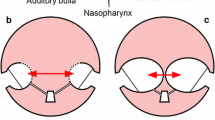Summary
-
1.
The middle ear of geckos, in common with other non-mammals, has a poor high-frequency response.
-
2.
The overall amplitude patterns shown by the middle ear are determined almost entirely by the response of the eardrum itself.
-
3.
The effect of uncoupling the inner-ear or columella from the drum on the drum amplitudes is small, and appears mainly as reduced damping on the low-frequency response.
-
4.
At low frequencies (below 2–4 kHz) the inferior process acts as a rigid bar, and is part of the lever system which acts on the columella. Above this frequency, the inferior process is no longer rigid and flexes, such that some energy is lost in the extracolumella and is not passed to the columella.
-
5.
The inferior process does not bend at high frequencies if the columella/inner ear is disconnected from the drum/extracolumella. The bending thus is probably due to a rising inner-ear impedance at the higher frequencies.
Similar content being viewed by others
References
Johnstone, B. M., Taylor, K. J., Boyle, A. J.: Mechanics of the guinea pig cochlea. J. acoust. Soc. Amer.47, 504–509 (1970).
Khanna, S. M., Tonndorf, J.: Middle ear power transfer. Arch. klin. exp. Ohr.-, Nas.- u. Kehlk.-Heilk.193, 78–88 (1969).
Manley, G. A.: A review of some current concepts of the functional evolution of the ear in terrestrial vertebrates. Evolution, in press (1972a).
Manley, G. A.: The middle ear of the Tokay gecko. J. comp. Physiol.81, 239–250 (1972b).
Manley, G. A., Irvine, D. R. F., Johnstone, B. M.: Frequency response of bat tympanic membrane. Nature (Lond.)237, 112–113 (1972).
Masterton, B., Heffner, H., Ravizza, R.: The evolution of human hearing. J. acoust. Soc. Amer.45, 966–985 (1969).
Saunders, J. C., Johnstone, B. M.: A comparative analysis of middle ear function in non-mammalian vertebrates. Acta otolaryng. (Stockh.)73, 353–361 (1972).
Werner, Y. L., Wever, E. G.: The function of the middle ear in lizards:Gekko gecko andEublepharis macularius (Gekkonoidea). J. exp. Zool.179, 1–16 (1972).
Wever, E. G., Werner, Y. L.: The function of the middle ear in lizards:Crotaphytus collaris (Igunadiae). J. exp. Zool.175, 327–342 (1970).
Author information
Authors and Affiliations
Additional information
Supported by Grant A6368 from the Canadian National Research Council, and a grant to B. M. Johnstone from the Australian Research Grants Committee. This work was carried out while the author was a Queen Elizabeth II Fellow at the University of Western Australia. I thank B. M. Johnstone for generously putting his equipment at my disposal for these experiments, and Roberta Webster and Debbie Nolte for expert technical assistance.
Rights and permissions
About this article
Cite this article
Manley, G.A. Frequency response of the middle ear of geckos. J. Comp. Physiol. 81, 251–258 (1972). https://doi.org/10.1007/BF00693630
Received:
Issue Date:
DOI: https://doi.org/10.1007/BF00693630




